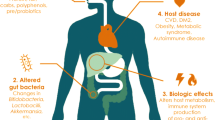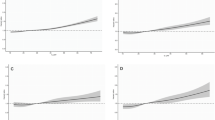Abstract
This case–cohort study examined the association between plasma enterolactone concentration and incidence of colon and rectal cancer in the Diet, Cancer and Health cohort, which enrolled 57,053 participants aged 50–64. Information about diet and lifestyle was obtained by questionnaire, and data on prescriptions of antibiotics were obtained from the Danish Prescription Registry. Cases diagnosed during 5.9 years of follow-up and a randomly selected sample of the cohort had a plasma sample analyzed for enterolactone by time-resolved fluoro-immuno assay. Associations were analyzed by Cox proportional hazards model. A total of 244 colon cancer cases, 137 rectal cancer cases, and 370 sub-cohort members were included in the statistical analyses. For each doubling in enterolactone concentration, we found lower risk of colon cancer among women [IRR (95% CI) = 0.76 (0.60–0.96)] and a tendency toward lower risk of rectal cancer [IRR (95% CI) = 0.83 (0.60–1.14)]. Among men, a doubling in enterolactone tended to be associated with higher risk of colon cancer [IRR (95% CI) = 1.09 (0.89–1.34)] and was associated with statistically significantly higher risk of rectal cancer [IRR (95% CI) = 1.74 (1.25–2.44)]. Exclusion of antibiotics users strengthened the results slightly. In conclusion, with higher enterolactone levels, we found lower risk of colon cancer among women and higher risk of rectal cancer among men.
Similar content being viewed by others
References
Saarinen NM, Smeds A, Makela SI et al (2002) Structural determinants of plant lignans for the formation of enterolactone in vivo. J Chromatogr B Analyt Technol Biomed Life Sci 777:311–319
Mazur W (1998) Phytoestrogen content in foods. Baillieres Clin Endocrinol Metab 12:729–742
Mazur W, Adlercreutz H (1998) Natural and anthropogenic environmental oestrogens: the scientific basis for risk assessment. Pure Appl Chem 70:1759–1776
Axelson M, Setchell KD (1981) The excretion of lignans in rats—evidence for an intestinal bacterial source for this new group of compounds. FEBS Lett 123:337–342
Stitch SR, Toumba JK, Groen MB et al (1980) Excretion, isolation and structure of a new phenolic constituent of female urine. Nature 287:738–740
Nesbitt PD, Lam Y, Thompson LU (1999) Human metabolism of mammalian lignan precursors in raw and processed flaxseed. Am J Clin Nutr 69:549–555
Rowland IR, Wiseman H, Sanders TA, Adlercreutz H, Bowey EA (2000) Interindividual variation in metabolism of soy isoflavones and lignans: influence of habitual diet on equol production by the gut microflora. Nutr Cancer 36:27–32
Adlercreutz H (2002) Phyto-oestrogens and cancer. Lancet Oncol 3:364–373
Kilkkinen A, Pietinen P, Klaukka T, Virtamo J, Korhonen P, Adlercreutz H (2002) Use of oral antimicrobials decreases serum enterolactone concentration. Am J Epidemiol 155:472–477
Setchell KD, Lawson AM, Mitchell FL, Adlercreutz H, Kirk DN, Axelson M (1980) Lignans in man and in animal species. Nature 287:740–742
Adlercretutz H, Heikkinen R, Woods M, Fotsis T, Dwyer JT, Goldin BR (1982) Excretion of the lignans enterolactone and enterodiol and of equol in omnivorous and vegetarian postmenopausal women and in women with breast cancer. Lancet 11:1295–1298
Mueller SO, Simon S, Chae K, Metzler M, Korach KS (2004) Phytoestrogens and their human metabolites show distinct agonistic and antagonistic properties on estrogen receptor alpha (ERalpha) and ERbeta in human cells. Toxicol Sci 80:14–25
Penttinen P, Jaehrling J, Damdimopoulos AE et al (2007) Diet-derived polyphenol metabolite enterolactone is a tissue-specific estrogen receptor activator. Endocrinology 148:4875–4886
Kitts DD, Yuan YV, Wijewickreme AN, Thompson LU (1999) Antioxidant activity of the flaxseed lignan secoisolariciresinol diglucoside and its mammalian lignan metabolites enterodiol and enterolactone. Moll Cell Biochem 202:91–100
Niemeyer HB, Metzler M (2003) Differences in the antioxidant capacity of plant and mammalian lignans. J Food Eng 56:255–256
Prasad K (2000) Antioxidant activity of secoisolariciresinol diglucoside-derived metabolites, secoisolariciresinol, enterodiol, and enterolactone. Int J Angiol 9:220–225
Danbara N, Yuri T, Tsujita-Kyutoku M, Tsukamoto R, Uehara N, Tsubura A (2005) Enterolactone induces apoptosis and inhibits growth of Colo 201 human colon cancer cells both in vitro and in vivo. Anticancer Res 25:2269–2276
Mousavi Y, Adlercreutz H (1992) Enterolactone and estradiol inhibit each other’s proliferative effect on MCF-7 breast cancer cells in culture. J Steroid Biochem Mol Biol 41:615–619
Brooks JD, Thompson LU (2005) Mammalian lignans and genistein decrease the activities of aromatase and 17beta-hydroxysteroid dehydrogenase in MCF-7 cells. J Steroid Biochem Mol Biol 94:461–467
Sung MK, Lautens M, Thompson LU (1998) Mammalian lignans inhibit the growth of estrogen-independent human colon tumor cells. Anticancer Res 18:1405–1408
Konstantinopoulos PA, Kominea A, Vandoros G et al (2003) Oestrogen receptor beta (ERbeta) is abundantly expressed in normal colonic mucosa, but declines in colon adenocarcinoma paralleling the tumour’s dedifferentiation. Eur J Cancer 39:1251–1258
Wada-Hiraike O, Warner M, Gustafsson JA (2006) New developments in oestrogen signalling in colonic epithelium. Biochem Soc Trans 34:1114–1116
Castiglione F, Taddei A, Degl’Innocenti DR et al (2008) Expression of estrogen receptor beta in colon cancer progression. Diagn Mol Pathol 17:231–236
Jassam N, Bell SM, Speirs V, Quirke P (2005) Loss of expression of oestrogen receptor beta in colon cancer and its association with Dukes’ staging. Oncol Rep 14:17–21
Xie LQ, Yu JP, Luo HS (2004) Expression of estrogen receptor beta in human colorectal cancer. World J Gastroenterol 10:214–217
Hebert-Croteau N (1998) A meta-analysis of hormone replacement therapy and colon cancer in women. Cancer Epidemiol Biomarkers Prev 7:653–659
Nelson HD, Humphrey LL, Nygren P, Teutsch SM, Allan JD (2002) Postmenopausal hormone replacement therapy: scientific review. JAMA 288:872–881
Kuijsten A, Hollman PC, Boshuizen HC et al (2008) Plasma enterolignan concentrations and colorectal cancer risk in a nested case–control study. Am J Epidemiol 167:734–742
Ward H, Chapelais G, Kuhnle GG, Luben R, Khaw KT, Bingham S (2008) Lack of prospective associations between plasma and urinary phytoestrogens and risk of prostate or colorectal cancer in the European Prospective into Cancer-Norfolk study. Cancer Epidemiol Biomarkers Prev 17:2891–2894
Tjonneland A, Olsen A, Boll K et al (2007) Study design, exposure variables, and socioeconomic determinants of participation in Diet, Cancer and Health: a population-based prospective cohort study of 57,053 men and women in Denmark. Scand J Public Health 35:432–441
Overvad K, Tjonneland A, Haraldsdottir J, Ewertz M, Jensen OM (1991) Development of a semiquantitative food frequency questionnaire to assess food, energy and nutrient intake in Denmark. Int J Epidemiol 20:900–905
Tjonneland A, Overvad K, Haraldsdottir J, Bang S, Ewertz M, Jensen OM (1991) Validation of a semiquantitative food frequency questionnaire developed in Denmark. Int J Epidemiol 20:906–912
Tjonneland A, Haraldsdottir J, Overvad K, Stripp C, Ewertz M, Jensen OM (1992) Influence of individually estimated portion size data on the validity of a semiquantitative food frequency questionnaire. Int J Epidemiol 21:770–777
Lauritsen J (1998) Foodcalc 1.3
Probert CJ, Emmett PM, Heaton KW (1993) Intestinal transit time in the population calculated from self made observations of defecation. J Epidemiol Community Health 47:331–333
Gaist D, Sorensen HT, Hallas J (1997) The Danish prescription registries. Dan Med Bull 44:445–448
Adlercreutz H, Wang GJ, Lapcik O et al (1998) Time-resolved fluoroimmunoassay for plasma enterolactone. Anal Biochem 265:208–215
Stumpf K, Uehara M, Nurmi T, Adlercreutz H (2000) Changes in the time-resolved fluoroimmunoassay of plasma enterolactone. Anal Biochem 284:153–157
Prentice RL (1986) A case–cohort design for epidemiologic cohort studies and disease prevention trials. Biometrika 73:1–11
Barlow WE, Ichikawa L, Rosner D, Izumi S (1999) Analysis of case–cohort designs. J Clin Epidemiol 52:1165–1172
Lin DY, Wei LJ (1989) The robust inference for the cox proportional hazards model. J Am Stat Assoc 84:1074–1078
Johnsen NF, Hausner H, Olsen A et al (2004) Intake of whole grains and vegetables determines the plasma enterolactone concentration of Danish women. J Nutr 134:2691–2697
Johnsen NF, Christensen J, Thomsen BL et al (2006) Physical activity and risk of colon cancer in a cohort of Danish middle-aged men and women. Eur J Epidemiol 21:877–884
Horner NK, Kristal AR, Prunty J, Skor HE, Potter JD, Lampe JW (2002) Dietary determinants of plasma enterolactone. Cancer Epidemiol Biomarkers Prev 11:121–126
Hulten K, Winkvist A, Lenner P, Johansson R, Adlercreutz H, Hallmans G (2002) An incident case-referent study on plasma enterolactone and breast cancer risk. Eur J Nutr 41:168–176
Kilkkinen A, Stumpf K, Pietinen P, Valsta LM, Tapanainen H, Adlercreutz H (2001) Determinants of serum enterolactone concentration. Am J Clin Nutr 73:1094–1100
Lampe JW, Gustafson DR, Hutchins AM et al (1999) Urinary isoflavonoid and lignan excretion on a Western diet: relation to soy, vegetable, and fruit intake. Cancer Epidemiol Biomarkers Prev 8:699–707
Milder IE, Kuijsten A, Arts IC et al (2007) Relation between plasma enterodiol and enterolactone and dietary intake of lignans in a Dutch endoscopy-based population. J Nutr 137:1266–1271
Sonestedt E, Borgquist S, Ericson U et al (2008) Enterolactone is differently associated with estrogen receptor beta-negative and -positive breast cancer in a Swedish nested case–control study. Cancer Epidemiol Biomarkers Prev 17:3241–3251
Vanharanta M, Mursu J, Nurmi T et al (2002) Phloem fortification in rye bread elevates serum enterolactone level. Eur J Clin Nutr 56:952–957
Kuijsten A, Arts IC, Hollman PC, van’t Veer P, Kampman E (2006) Plasma enterolignans are associated with lower colorectal adenoma risk. Cancer Epidemiol Biomarkers Prev 15:1132–1136
Carreau C, Flouriot G, netau-Pelissero C, Potier M (2008) Enterodiol and enterolactone, two major diet-derived polyphenol metabolites have different impact on ERalpha transcriptional activation in human breast cancer cells. J Steroid Biochem Mol Biol 110:176–185
Martin ME, Haourigui M, Pelissero C, Benassayag C, Nunez EA (1996) Interactions between phytoestrogens and human sex steroid binding protein. Life Sci 58:429–436
Schottner M, Gansser D, Spiteller G (1997) Lignans from the roots of Urtica dioica and their metabolites bind to human sex hormone binding globulin (SHBG). Planta Med 63:529–532
Hausner H, Johnsen NF, Hallund J, Tetens I (2004) A single measurement is inadequate to estimate enterolactone levels in danish postmenopausal women due to large intraindividual variation. J Nutr 134:1197–1200
Bach Knudsen KE, Serena A, Kjaer AK et al (2003) Rye bread in the diet of pigs enhances the formation of enterolactone and increases its levels in plasma, urine and feces. J Nutr 133:1368–1375
Souhami RL, Tannock I, Hohenberger P, Horiot J-C (2002) Oxford textbook of oncology. Oxford: Oxford University Press
Sonnenberg A, Muller AD (1993) Constipation and cathartics as risk factors of colorectal cancer: a meta-analysis. Pharmacology 47(Suppl 1):224–233
Kirkman LM, Lampe JW, Campbell DR, Martini MC, Slavin JL (1995) Urinary lignan and isoflavonoid excretion in men and women consuming vegetable and soy diets. Nutr Cancer 24:1–12
Heaton KW, Radvan J, Cripps H, Mountford RA, Braddon FE, Hughes AO (1992) Defecation frequency and timing, and stool form in the general population: a prospective study. Gut 33:818–824
Probert CS, Emmett PM, Heaton KW (1995) Some determinants of whole-gut transit time: a population-based study. QJM 88:311–315
Roberts MC, Millikan RC, Galanko JA, Martin C, Sandler RS (2003) Constipation, laxative use, and colon cancer in a North Carolina population. Am J Gastroenterol 98:857–864
Iacopetta B (2002) Are there two sides to colorectal cancer? Int J Cancer 101:403–408
Benassayag C, Perrot-Applanat M, Ferre F (2002) Phytoestrogens as modulators of steroid action in target cells. J Chromatogr B Analyt Technol Biomed Life Sci 777:233–248
Matthews J, Gustafsson JA (2003) Estrogen signaling: a subtle balance between ER alpha and ER beta. Mol Interv 3:281–292
Acknowledgments
We gratefully acknowledge Katja Boll (programmer, Danish Cancer Society), Connie Stripp (dietician, Danish Cancer Society), and Jytte Fogh Larsen (secretary, Danish Cancer Society) for their contribution in the collection and handling of the data. We thank Winnie Østergaard Thomsen (laboratory technician, Aarhus University, Faculty of Agricultural Sciences) for excellent technical assistance with the biochemical determinations of enterolactone. Financial support: The Danish Cancer Society, Danish Medical Research Counsil, Danish Graduate School in Public Health, Danske Banks Foundation, Foundation of Graduate Engineer Bent Bøgh, and Wife Inge Bøgh.
Author information
Authors and Affiliations
Corresponding author
Rights and permissions
About this article
Cite this article
Johnsen, N.F., Olsen, A., Thomsen, B.L.R. et al. Plasma enterolactone and risk of colon and rectal cancer in a case–cohort study of Danish men and women. Cancer Causes Control 21, 153–162 (2010). https://doi.org/10.1007/s10552-009-9445-5
Received:
Accepted:
Published:
Issue Date:
DOI: https://doi.org/10.1007/s10552-009-9445-5




